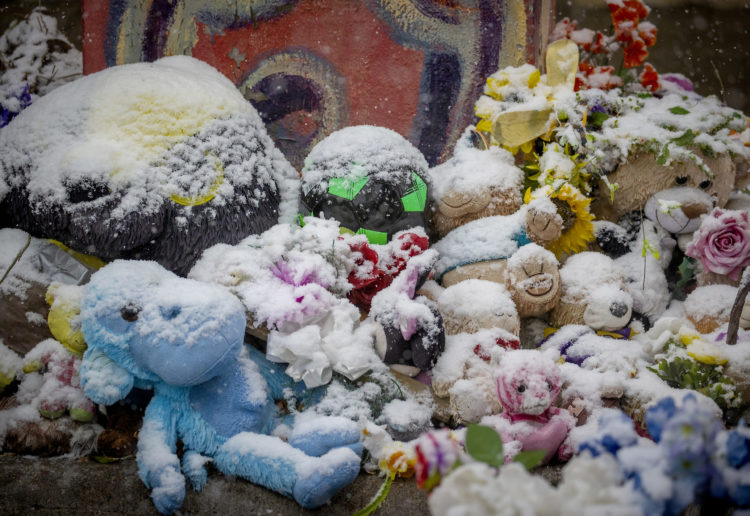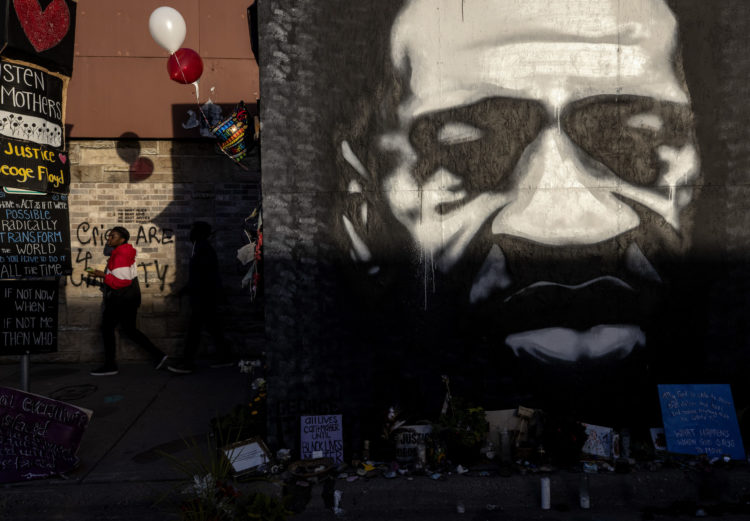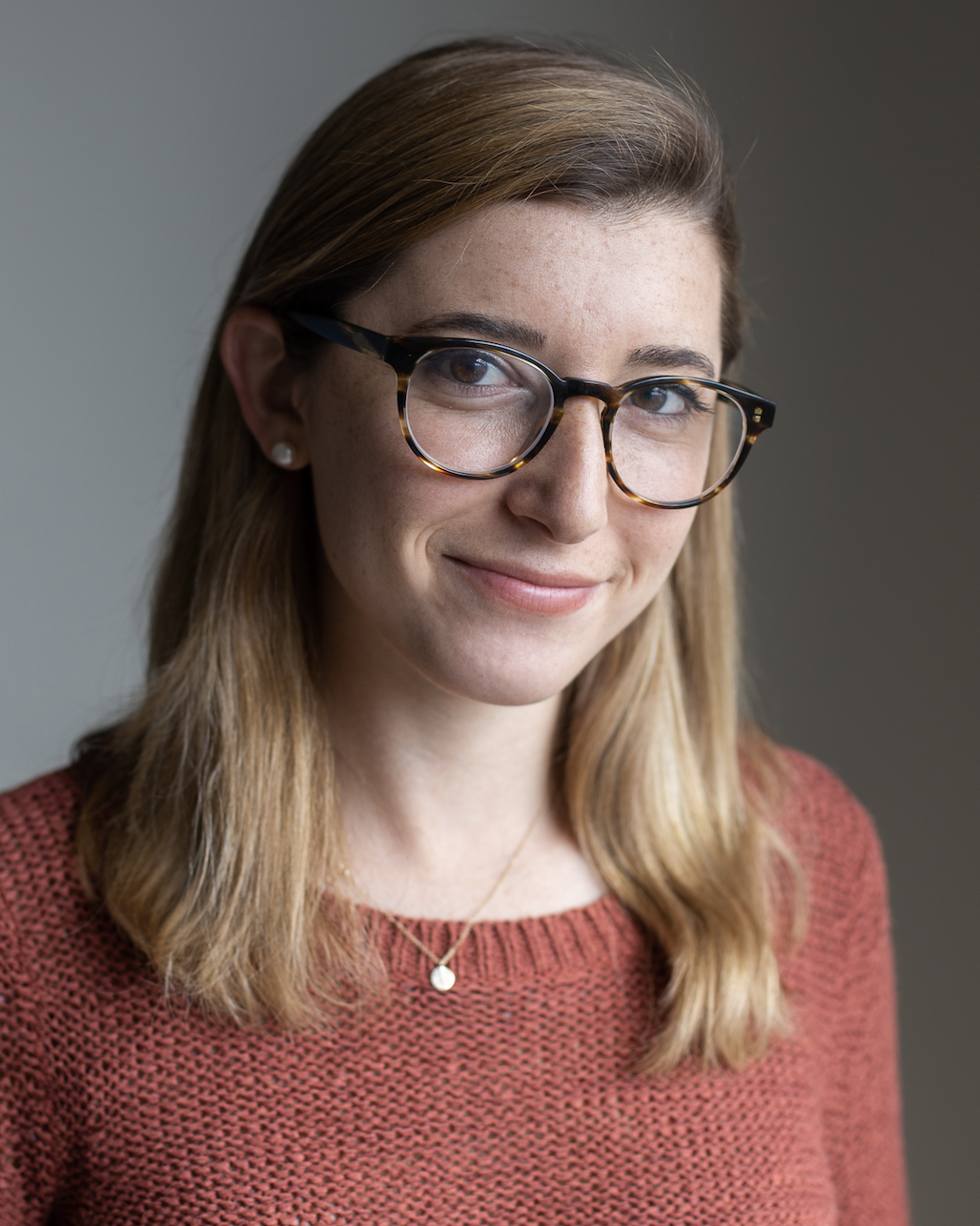
A memorial to George Floyd remains on the street corner in Minneapolis in mid-October as winter set in, five months after Floyd died while being restrained by Minneapolis police on May 25, 2020. His death prompted national protests against police violence and racism.
Those questions would become a compass of sorts as Ginsberg, national editor for The Washington Post, helped to oversee “George Floyd’s America,” the Post’s multi-platform series about how systemic racism shaped Floyd’s experience. Months after Floyd’s death, Ginsberg’s team had the time and space to give his life a fuller examination. With that opportunity, of course, came tremendous responsibility to get it right.
If reporters’ mandates were to burrow deeply into one chapter of Floyd’s life in relation to a singular institution — the education system, for instance — then Ginsberg’s mission was to create the sum of those parts. He worked to ensure each piece echoed and complemented but did not repeat the others. The goal: to yield a cohesive pattern of one man’s life — full of the complexity and nuance all too often stripped from news stories that follow the deaths of Black people at the hands of police — and link it with larger systems that can be difficult to grasp.
Ginsberg, a longtime D.C. resident who has spent more than two decades at The Post, has plenty of experience being a connector. He has held wide-ranging roles, from copy aide to metro reporter to local politics editor, and has been an editor on five Pulitzer Prize-winning projects.
We also featured a conversation with Post reporter Robert Samuels, who was the lead reporter on one of the six stories in the series. Here, we focus on the editing in a conversation with Ginsberg: How he shaped this series from a mountaintop view, why each piece needed to have “a lot of cooks in the kitchen” and the importance of giving reporters ample time to do their job rigorously (and responsibly). Our conversation has been edited for length and clarity.

A memorial for police violence victim George Floyd at a racial justice rally to observe what would have been George Floyd's 47th birthday, Oct. 14, 2020.
I’d love to know how this series was conceived. How did some of the assignments begin and evolve with the reporting?
After the whole world saw what happened to George Floyd, I pulled together some conversations about what we could do. Beyond covering the immediate news, there was clearly something bigger that needed to be done. From that, there were a couple of really strong ideas that merged into this series. One was the idea that the whole world watched George Floyd die, and we wanted to tell the story of his life — what came before that. We also wanted to tell the story of systemic racism, which was at least part of that story. And so we talked around and around about how to do that. After a while, it became clear that the way to do that was through George Floyd’s life. What we all saw in that video was a piece of it, but there were many things that had come before. And the way to honor him and to get at the subject would be to tell that story.
The series played out really as we imagined it. The first piece was an overview of his own life and his family’s life and gave a lot of strong background about what he was born into. And then some sense of what came after. Then we just broke it down by system. He had gone to a school system that struggled; we wanted to tell that story. He had lived in a neighborhood that was governed by housing policies that were anything but fair; we wanted to tell that story. There was Robert Samuels’ story about health, which is an increasing area of interest; as was written in the story, being Black is its own pre-existing condition. There was the story of the criminal justice system and his time with the police because those are critical stories to tell. When you put it all together, it’s a story about Floyd, but really a story about these systems.
I was struck by how many different people contributed to this project, all playing different roles. How did the collaborative aspect of this project distinguish it from the day-to-day work you might normally do?
We’re extremely lucky to have enormously talented people that cover all of the things that we wrote about, and a collaborative culture. My initial meetings included people from different departments, which is not unusual at The Post. When it became clear what the story should be, then the main authors also became clear.
We wanted to move quickly. This is an issue that deserved fuller treatment but also deserved to be done somewhat quickly. So we basically gave everyone six to eight weeks to come up with an initial draft, and then another six weeks or so before we published. That’s a pretty tight timeline for something of this magnitude. But we felt strongly that it needed to run before Election Day, before we got too far from the moment.
What kinds of conversations were you having with reporters as their stories developed and what kinds of conversation were they having with each other? Of course, these systems overlap and this is one man’s life. How did you facilitate that dialogue?
We had a set of meetings every Monday with each of the reporters, and a group meeting every Friday which grew to include all the names you saw at the bottom of the series. The reporters were clearly talking to each other in between, which was great. It was a coordinated effort, even though everyone was doing separate things. Some of the reporting overlapped and it was important that they were all aware of how that happened.
Many of our conversations with reporters were about trying to simplify things. These are big, difficult topics. How are we going to make it simple? How are we going to make it relatable? How are we going to tell the story that we want to tell without losing readers? Even within specific topics, you could choose many ways to go on a story about housing, for example, or education.
What were some of the most challenging ethical questions about helming a series like this? Robert Samuels and I spoke about how the reporting developed in relation to George Floyd’s drug use — when that information came out and how that shaped what his piece had to do, or not do. I’m curious how you approached what to include and exclude, and how much space to give different points of Floyd’s life.
We had a moment early on in one of our meetings when someone said, ‘I just want to ask, are we qualified to tell this story? Can we do it justice?’ And that was a great question. We talked it through, and my feeling with this story — as with all stories — is that we have the language to do it. We have the expertise to do it. If we did it together — with everyone reading everyone’s story, with us all collaborating on all the stories — we could find a way to tell it honestly and compassionately. So from that conversation, this became a priority that we were all mindful of.
In terms of balance, there’s no one thing that defines anyone. It was important not to gloss over anything in George Floyd’s life but it was also important to put it all in perspective.
Do you find it challenging to have so many cooks in the kitchen?
In this case, no. It was partly because of that original question, ‘Are we qualified to do this?’ It was a series that needed a lot of cooks. The role of editors was to make sure that it all fit together. This is a project that really benefited from having a lot of people.
What were some of the most difficult calls you had to make?
How to narrow the scope of some of the stories. There’s just so much. When you start digging in on any one side — but especially George Floyd’s life — you find so much, and it makes you want to share it all, to tell it all, to do what you can with it. But there can be too much, and then you lose focus and lose the sense of what you’re trying to say. So we had a lot that we left out of stories, which can be hard — especially for reporters who work so hard to get information and want to use it all. But in some cases, it just pulls from the main point.
I’m wondering if you can speak to how you thought about the tension between elevating George Floyd’s choices and his personality, as an individual, and the broader structures he was operating in. That relationship between agency and the forces working against him is fascinating, and I’m curious if this was a part of early conversations or influenced how you shaped each piece.
In a big sense, that was something we were mindful of all along. Good chunks of the line edits were about that — there needs to be a sense of agency within the systems that affected him. That’s where we spent time trying to get it just right: ‘In this line, does he have the agency he ought to have?’ We looked it over and talked it through. In most cases, I think we all kind of saw things the same way. There were a couple of instances where some people felt that something was too much this way, or too much that way. In those cases, we found different language to get it right.
This series clearly shows that if you give reporters time to dig deep, you can find deep results. The Post is probably one of the few places nowadays that is still well-resourced enough to have such a deep bench of staff, who can really take the time and space to pull off a series like this. How did you think about what The Post can do, and ought to do, in the struggling media landscape? Was this something you considered, in terms of what coverage of George Floyd already existed and what was missing?
As The Post itself becomes more nationally focused, we hope to do more stories on this level. Investigative narrative is an amazing story form. But I think it’s important that we do so with the understanding that we may not go into stories as an expert on something like Houston’s housing policy. We need to give people the time to build that up so it doesn’t feel trite or cliche to people who live there. We have to be respectful of what they know and the lives they live, and not make them feel like some outsider just discovered something that isn’t right.
That was especially true in this case, where you can’t just read a few top-level clips and think you know what you’re talking about. In some ways, I think these stories were a model for other ones we’ll do — not just other series, but other intense efforts where we really get to know a place and then we tell you about it, rather than the other way around.
Along those lines, how has this series influenced what else The Post might undertake, in terms of breadth and depth? It strikes me that while George Floyd was incredibly emblematic of all these systems, it’s like you said: Once you start digging into anybody’s life, there’s so much there. How do you think about who gets that treatment?
That’s a really good question. I don’t have a set answer to that. In the vein of systemic racism, it’s important that we continue to do more. We can’t just do this series and think we’ve got it covered. But more broadly, it’s often a day-to-day thing. We’ve lived through a year of enormous stories: George Floyd, coronavirus, the election, the economy. Our approach for all of them is, ‘Here’s this big thing. What’s the important part of it that’s not being told that we can tell?’ From there, we figure it out.
Another example of this is The Post reporter, Greg Jaffe, who has been in the Orlando area all year writing about the economic fallout there. That grew out of his smart observations. We didn’t set out for him to spend a year in the Orlando area, but that’s what it became. That’s a different model, where you start to uncover something, and then you just want to keep going.
What did you hope that this series would do?
I’d like to think that we achieved what we set out to do, which was to tell the story of Floyd’s life — both about the way he lived it and the way that the world was forced upon him. I hope these six stories, and the video and the audio — which are very intimate aspects of the series that went a long way, and I think really improved it — does that justice.
***
Carly Stern is a freelance reporter based in San Francisco who covers housing, disability policy, urban life and economic inequality.


